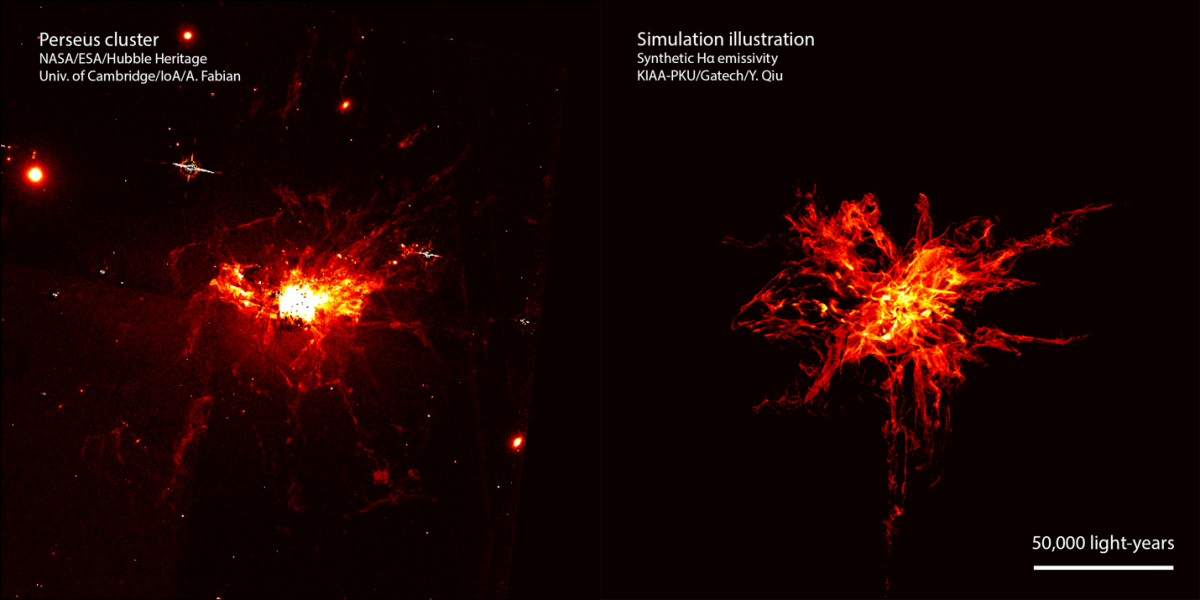Using state-of-the-art radiation-hydrodynamic simulations, KIAA postdoctoral fellow Dr. Yu Qiu and collaborators proposed a new framework for cold gas filament formation, shedding light on how cold gas exists immersed in the hot, X-ray-emitting plasma permeating galaxy clusters. Their findings are published in a recent Nature Astronomy Letter.
In our Universe, galaxy clusters are the largest collapsed structures, containing hundreds to thousands of galaxies bound together by dark matter. Some of the most massive black holes in the universe are found at the centers of these clusters, and are called active galactic nuclei (AGN) when they are gulping down a lot of surrounding material. Some of the energy from the accreted matter is converted into energetic plasma and photons, which then interacts with the rest of the galaxy, a process called AGN feedback. Using radiation-hydrodynamic simulations of AGN feedback, Qiu and collaborators studied how the warm gas in galaxy clusters cools and forms filaments that extend beyond 100,000 light years from the central supermassive black hole.

Figure 1. Comparison of the Hubble Space Telescope observation of the filaments in the Perseus cluster (left) with Hα emissivity illustration of the simulated cluster (right). Hα line emission is an optical tracer for cold gas around T ≈ 10,000 K.
Previous theories suggested that cold gas forms directly as a consequence of thermal instability. The gas falls towards the center of the cluster, leaving a filamentary trail. However, new simulations led by Dr. Qiu for the first time show that outflowing gas powered by AGN feedback, rather than infalling gas, is the key in driving the formation of these filaments. The authors explain that the outflowing gas with initial temperatures in the range between 104 and 107 Kelvin has a short cooling timescale compared to the time it takes to reach its maximum height, thus forming cold, filamentary gas along its rising trajectory. The filaments that form in this way share remarkable resemblance with optical observations of the cold filaments seen at the centers of galaxy clusters (see figure).
In these same clusters, observations of filaments at optical wavelengths are often co-spatial with dust emission, a correlation that further supports the model developed by Qiu’s team. Unlike the atmosphere on Earth, intracluster space is permeated by hot plasma that is primarily comprised of hydrogen and helium with temperatures as high as 108 Kelvin. Astronomical “dust”, on the other hand, are cold molecules bound together, with sizes up to a few millimeters. Since dust can be quickly destroyed in the hot plasma, it is unlikely that dusty filaments form from the hot X-ray gas. Instead, the authors show that dust can be preserved in outflows whose initial temperature is below a few million Kelvin, in line with the criterion for the gas to cool before reaching maximum height.
The ideas advanced in this work, according to the authors, provide new insights into a long-standing open question about the origin of the cold gas filaments, as well as a new framework in which to interpret the impact of outflows driven by AGN feedback in galaxy clusters, shedding light on how supermassive black holes interact with the surrounding medium.
Yu Qiu acknowledges support from the National Key R&D Program of China (2016YFA0400702), the National Science Foundation of China (11721303, 11991052), and the High-Performance Computing Platform of Peking University. Support for this work was in part provided by the National Aeronautics and Space Administration through Chandra Award Number TM7-18008X issued by the Chandra X-ray Center, which is operated by the Smithsonian Astrophysical Observatory for and on behalf of the National Aeronautics Space Administration under contract NAS803060. This research was supported in part by the National Science Foundation under Grant No. NSF PHY-1748958, and in part through research cyberinfrastructure resources and services provided by the Partnership for an Advanced Computing Environment (PACE) at the Georgia Institute of Technology, Atlanta, Georgia, USA. Any opinions, findings, and conclusions or recommendations expressed in this material are those of the authors and do not necessarily reflect the views of the Smithsonian Astrophysical Observatory and or the National Aeronautics and Space Administration. Illustration courtesy of the Chandra X-ray Observatory Center, which is operated by the Smithsonian Astrophysical Observatory on behalf of NASA, and the Georgia Institute of Technology.
Related links:
Chandra’s compilation of Perseus images:
https://chandra.harvard.edu/photo/2008/perseus/more.html
Publication link:
https://www.nature.com/articles/s41550-020-1090-7
Nature Astronomy Community—Behind the paper blog post:
https://go.nature.com/2VK2pld
PKU News:https://news.pku.edu.cn/jxky/93002f11b9fe49e7a0be7edda0ac02cf.htm